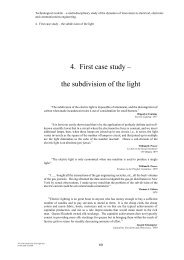Valuation Techniques for Social Cost-Benefit Analysis: - HM Treasury
Valuation Techniques for Social Cost-Benefit Analysis: - HM Treasury
Valuation Techniques for Social Cost-Benefit Analysis: - HM Treasury
Create successful ePaper yourself
Turn your PDF publications into a flip-book with our unique Google optimized e-Paper software.
28<br />
well-trained interviewers (Carson, 2000). In<strong>for</strong>mation bias occurs if non-neutrality or inaccuracy<br />
in what is presented influences responses.<br />
4.2.4 Econometric methodology<br />
All three valuation methods rest on using a sample of data collected from a population in order<br />
to draw inferences about that population. However, a number of statistical or econometric<br />
issues are specific to the revealed preference and life satisfaction approach. We consider five of<br />
these issues below:<br />
i. difficulties in causal analysis;<br />
ii. functional <strong>for</strong>m specification;<br />
iii. the potential <strong>for</strong> measurement error,<br />
iv. the fact that some values cannot be picked up; and<br />
v. partial values:<br />
i) Difficulties in causal analysis<br />
The most basic econometric approach in revealed preference and life satisfaction applications is<br />
the specification of a linear regression model that is then estimated using Ordinary Least<br />
Squares. In this setting, valid causal interpretations cannot be attached to parameter estimates if<br />
the included covariates are correlated with the disturbance term of the model. This may limit our<br />
ability to identify, <strong>for</strong> example, the causal effect of the non-market good on house prices or<br />
wages in a revealed preference model, or the causal impact of income and the non-market good<br />
on well-being in a life satisfaction model.<br />
With regard to the revealed preference method specifically, a large number of applications have<br />
indeed identified reasons to suggest that the non-market good of interest is correlated with the<br />
disturbance term. For example, in travel cost applications a number of cost components are<br />
chosen by the individual. Individuals who particularly enjoy the site under consideration are, <strong>for</strong><br />
example, likely to base their choice of residence with this in mind thereby lowering their travel<br />
cost . If so, the partial relationship between individual trip frequency and trip cost will there<strong>for</strong>e<br />
(patially) reflect this unobserved determinant and will not give the true relationship between cost<br />
and trip frequency <strong>for</strong> a randomly selected member of the population (Randall 1994).<br />
In studies valuing environmental amenities using housing markets, the large number of factors<br />
that influence the price of a house can lead to omitted variable bias. For example, individuals<br />
may accept a longer commute to work in order to live in an area with good air quality. There<strong>for</strong>e<br />
if commuting time is not controlled <strong>for</strong> in the hedonic model then the least squares estimated<br />
value of the environmental amenity will not capture the true effect. Similarly, in an analysis of<br />
the effect of water quality on house prices, Leggett and Bockstael (2000) note that shore-side<br />
residential properties nearer to water of higher quality are also likely to be further away from the<br />
emitters of pollution. There<strong>for</strong>e, if these emitters are undesirable neighbours <strong>for</strong> reasons distinct<br />
from their effect on water quality, then not controlling <strong>for</strong> a house‘s proximity to them will bias<br />
the estimated effect of water quality on house prices.<br />
It has also been suggested that job risk variables are endogenous in labour market hedonic<br />
studies. The main explanation <strong>for</strong> this is that unobservable individual characteristics determine<br />
both specific job assignment and wages. Support <strong>for</strong> this hypothesis is presented by Black et al<br />
(2003). Using the National Longitudinal Survey of Youth they find that test scores from the<br />
Armed Forces Qualification Test and self-reported illegal drug use are correlated with their jobrisk<br />
measures. This suggests that if such individual characteristics are not picked up by<br />
observable covariates, then least squares estimates of the implicit price <strong>for</strong> risk will be biased.





![AIRTO [Professor Dr Brian Blunden] - HM Treasury](https://img.yumpu.com/15492848/1/184x260/airto-professor-dr-brian-blunden-hm-treasury.jpg?quality=85)










